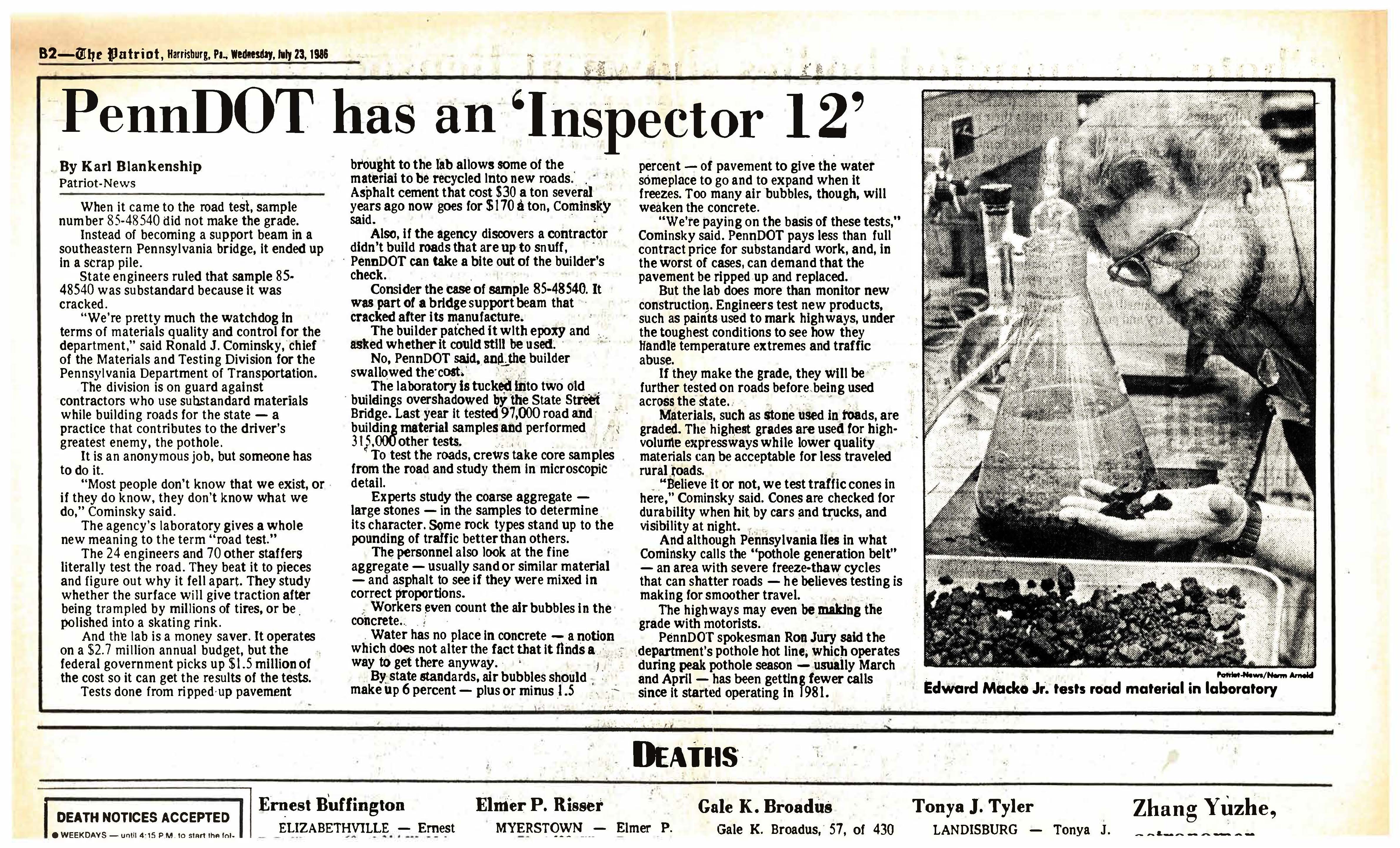PennDOT takes its road materials seriously, which is why we have a team of scientists and engineers devoted to testing the integrity of the products we use.
The department recently discovered an article from
The Patriot-News that ran on Wednesday, July 23, 1986, written by Karl Blankenship. Much has changed in 32 years, but our commitment to safety has not.
RELATED: PennDOT engineers build transportation future
 Click to view larger.
Click to view larger.
Here's the text of that entire article:
When it came to the road test, sample number 85-48540 did not make the grade.
Instead of becoming a support beam in a southeastern Pennsylvania bridge, it ended up in a scrap pile.
State engineers ruled that sample 85-48540 was substandard because it was cracked.
"We're pretty much the watchdog in terms of materials quality and control for the department," said Ronald J. Cominsky, chief of the Materials and Testing Division for the Pennsylvania Department of Transportation.
The division is on guard against contractors who use substandard materials while building roads for the state – a practice that contributes to the driver's greatest enemy,
the pothole.
It is an anonymous job, but someone has to do it.
"Most people don't know that we exist, or if they do know, they don't know what we do." Cominsky said.
The agency's laboratory gives a whole new meaning to the term "road test."
The 24 engineers and 70 staffers literally test the road. They beat it to pieces and figure out why it fell apart. They study whether the surface will give traction after being trampled by millions of tires, or be polished into a skating rink.
And the lab is a money saver. It operates on a $2.7 million annual budget, but the federal government picks up $1.5 million of the cost so it can get the results of the tests.
Tests done from ripped up pavement brought to the lab allows some of the material to be
recycled into new roads. Asphalt cement that cost $30 a ton several years ago now goes for $170 a ton, Cominsky said.
Also, if the agency discovers a contractor didn't build roads that are up to snuff, PennDOT can take a bite out of the builder's check.
Consider the case of sample 85-48540. It was part of a bridge support beam that cracked after its manufacture.
The builder patched it with epoxy and asked whether it could still be used.
No, PennDOT said, and the builder swallowed the cost.
The laboratory is tucked into two old buildings overshadowed by the State Street Bridge. Last year it tested 97,000 road and building material samples and performed 315,000 other tests.
To test the roads, crews take core samples from the road and study them in microscopic detail.
Experts study the coarse aggregate – large stones – in the samples to determine its character. Some rock types stand up to the pounding of traffic better than others.
The personnel also look at the fine aggregate – usually sand or similar material – and asphalt to see if they were mixed in correct proportions.
Workers even count the air bubbles in the concrete.
Water has no place in concrete – a notion which does not alter the fact that it finds a way to get there anyway.
By state standards, air bubbles should make up 6 percent – plus or minus 1.5 percent – of pavement to give the water someplace to go and to expand when it freezes. Too many air bubbles, though, will weaken the concrete.
"We're paying on the basis of these tests," Cominsky said. PennDOT pays less than full contract price for substandard work, and, in the worst of cases, can demand that the pavement be ripped up and replaced.
But the lab does more than monitor new construction. Engineers test new products, such as paints used to mark highways, under the toughest conditions to see how they handle temperature extremes and traffic abuse.
If they make the grade, they will be further tested on roads before being used across the state.
Materials, such as stone used in roads, are graded. The highest grades are used for high-volume expressways while lower quality material scan be acceptable for less traveled rural roads.
"Believe it or not, we test traffic cones in here," Cominsky said. Cones are checked for durability when hit by cars and trucks, and visibility at night.
And although Pennsylvania lies in what Cominsky calls the "pothole generation belt" – an area with
severe freeze-thaw cycles that can shatter roads – he believes testing is making for smother travel.
The highways may even be making the grade with motorists.
PennDOT spokesman Ron Jury said the department's
pothole hot line, which operates during peak pothole season – usually March and April – has been getting fewer calls since it started operating in 1982.
More Throwback Thursday articles: